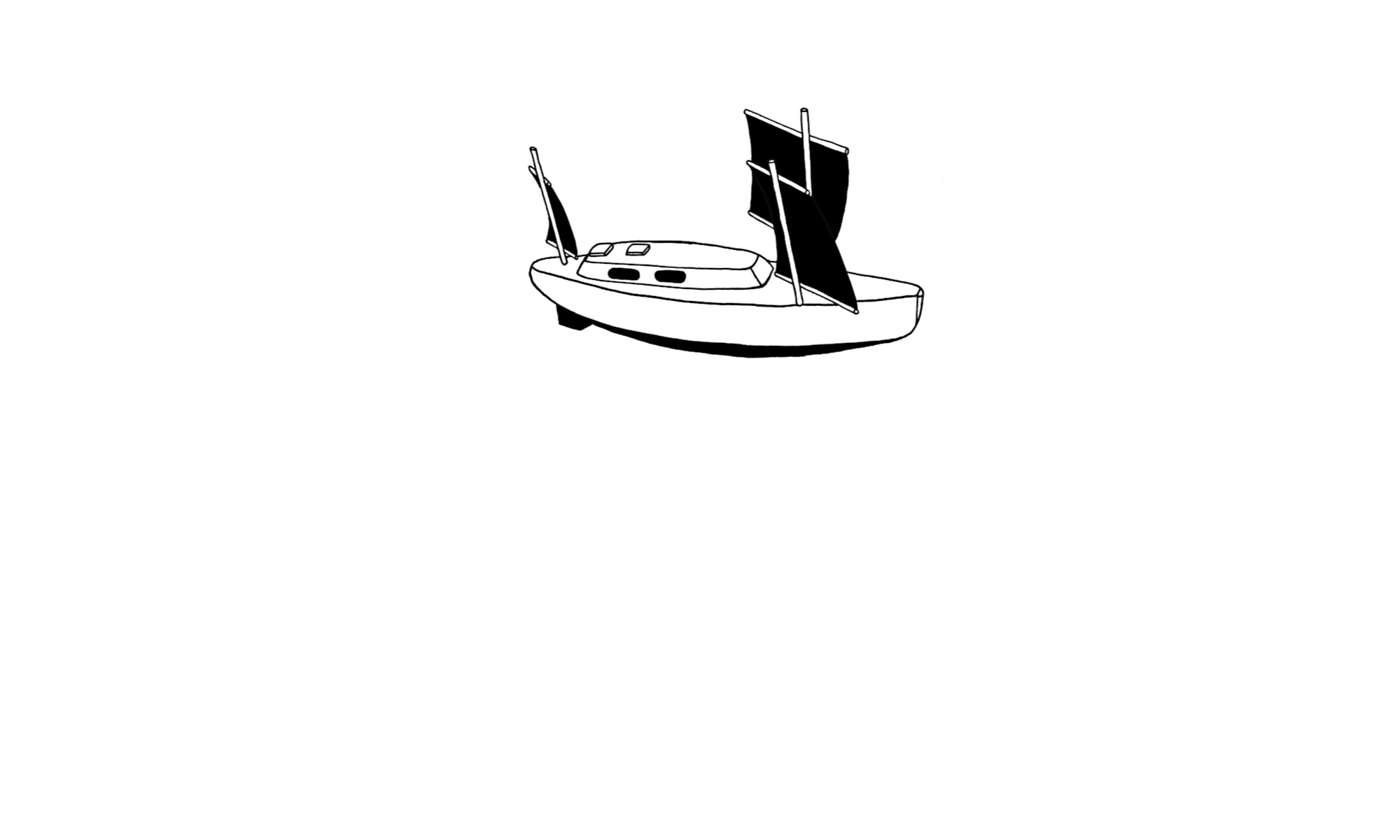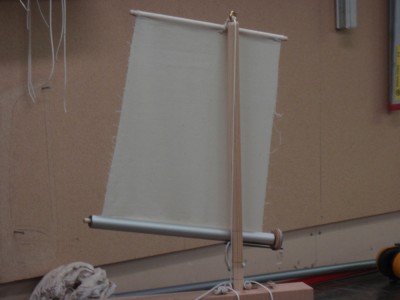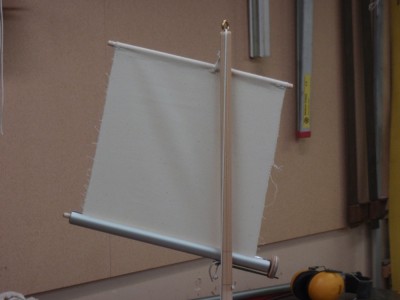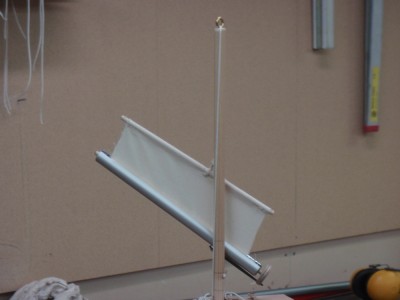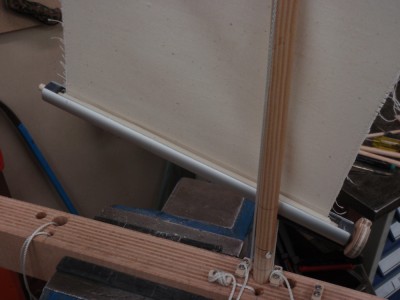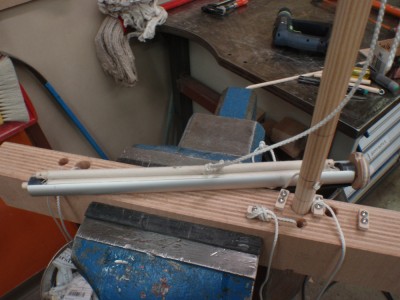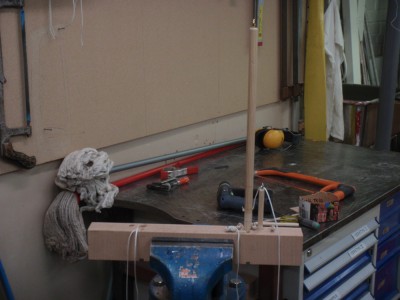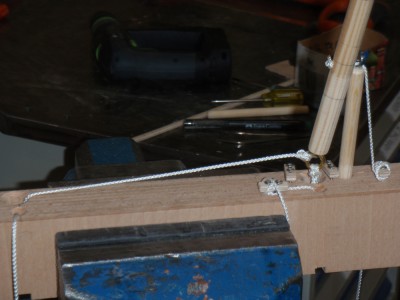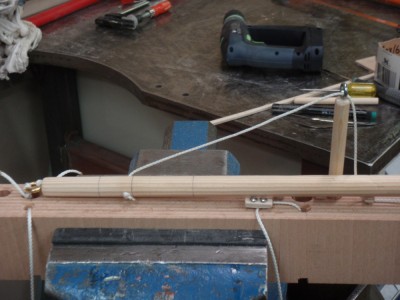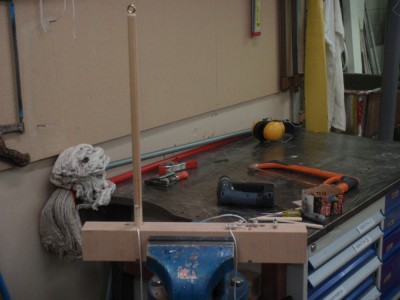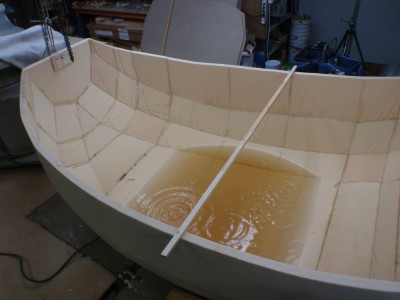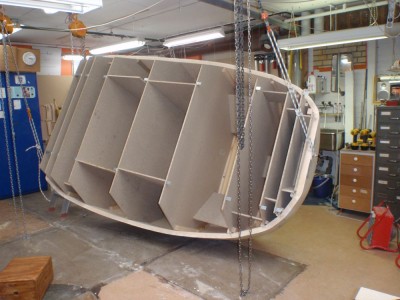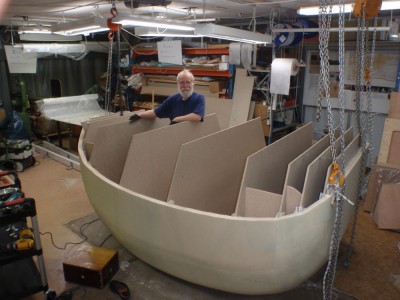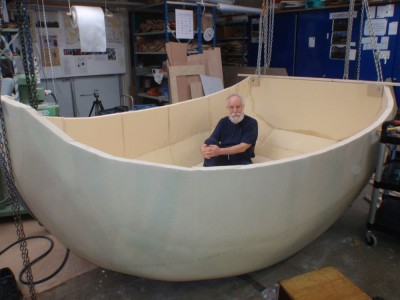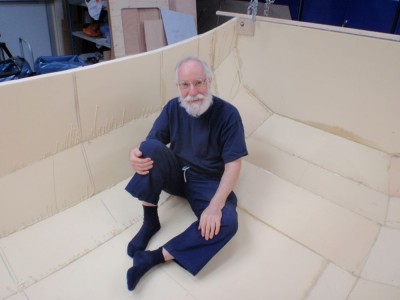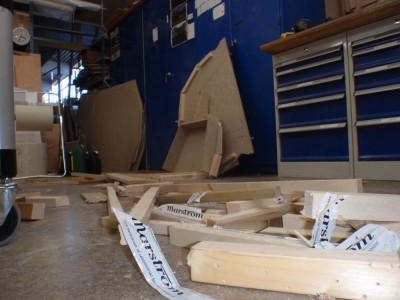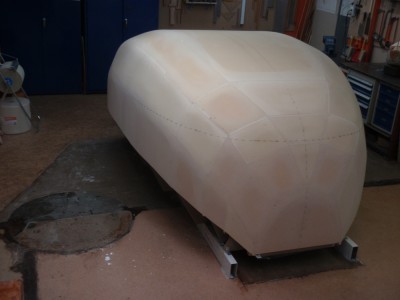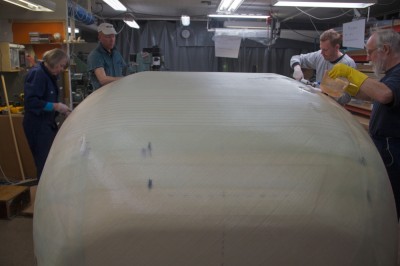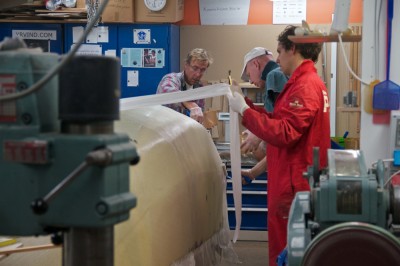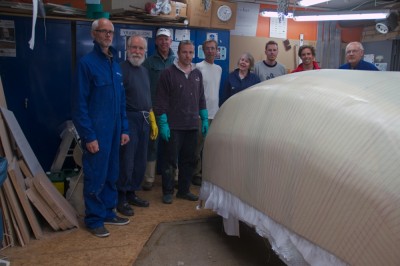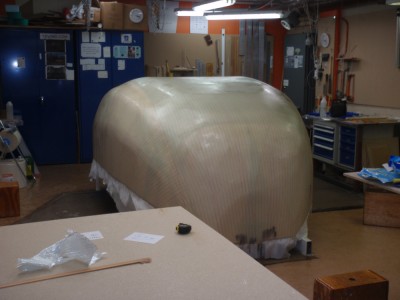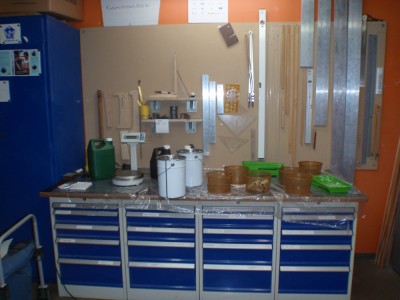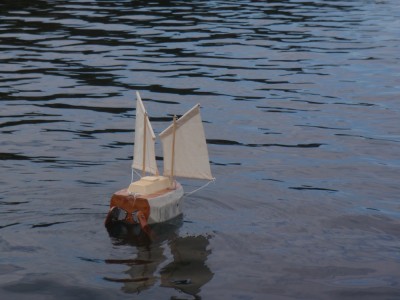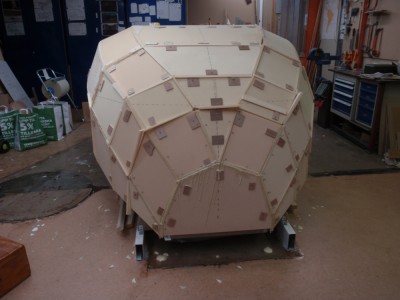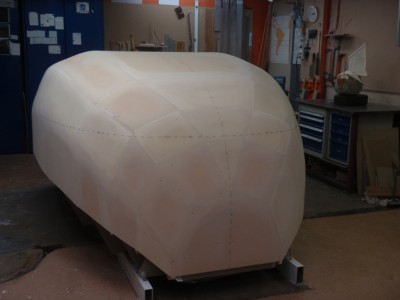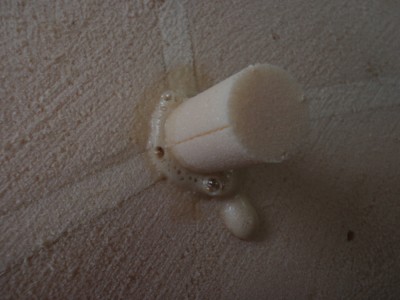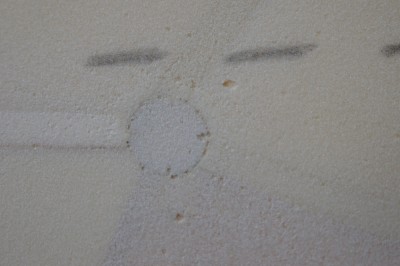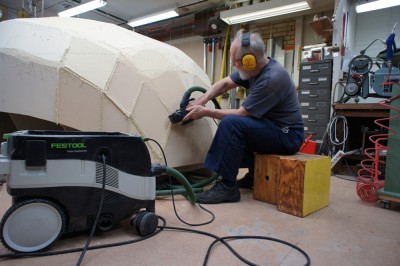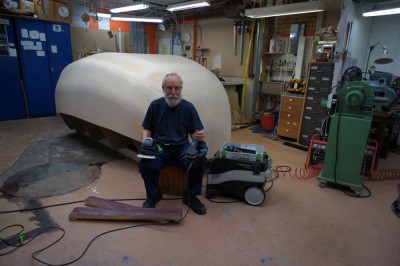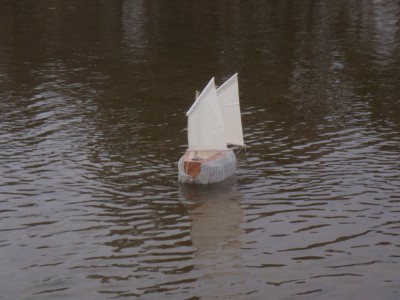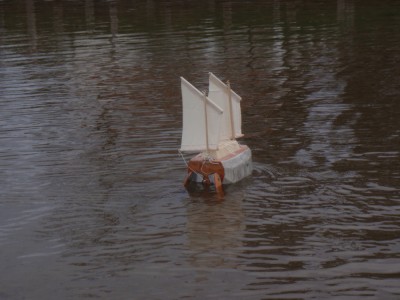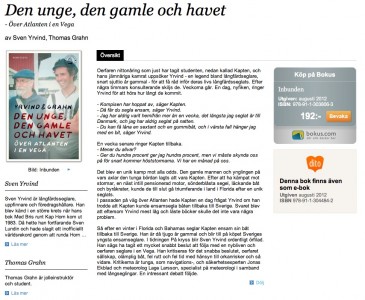In this film is Yrvind and some of his friends working with epoxy laminating. Yrvind is using epoxy products from Nils Malmgren AB, NM Epoxi. For you who are interested, the last layer which is applied in this film, is a peel ply layer. When it will be removed later, the surface will give better adhesion to coming layers.
ON CLEANING WITH VINEGAR
I am thanking Manie B for the suggestion of cleaning with vinegar. However the vinegar is an acid and the epoxy hardener is an alkaline. The two react with each other. The harm will probably be minimal but when I discessed the issue with my epoxy chemist he did not like the idea. Insted I have dried the inside of the hull and am grinding the Divinycell down to un-contaminated core, just in case.
To be continued…
Regards Yrvind.
ASPECTS OF THE RIG AND WATERCOLLECTION
Matt Layden did teach me the advantages of the lugsail. I did grow up with the traditional Swedish spritsail.
Paradox and Enigma uses a standing lug. I plan to use a balanced lug. Like Matt I intend to reef by rolling the sail around the boom. Unlike Matt I will keep the boom inside a slotted pipe, much the same as in-mast furling. Its a complication but it has some advatages. It protects the sail from chafe against the mast. It is easy to attach a preventer to the pipe. When the sail is not in use it functions as a sailcover. And important I will use the slotted boom to collect rain water in. A hose from it will lead to plastic containers.
There are two masts and four positions for them. The masts are selfsupported, unstaid. Thanks to the lugsail the masts will be very simple, no tracks and no goosenecks, only one halyard. I plan to make the mast of carbon at Marström. I will make them strong. They will not be longer than an oar (how long is an oar?) The will be as easy as an oar to handle.
They will be close to the hatch, within 3 feet, 90 cm. To move an mast it has first to be mowed vertically out of its support. Being of short statue and getting older every day some windy days I may need a helping hand in the form of a stick and some rope. Below follows some pictures click on them and click again to enlarge.
Full sail.
A reef.
A deeper reef.
The slot where water is collected.
The sail rolled into the boom and secured to the deck. The mast is free to be moved.
The mast and the helping stick and the lifting rope.
With the help of a rope the mast is lifted out of the mast hole. Each mast hole has a rope that can be attatched to the lower end of the mast and controlled from the deck. Its function is to secure the mast and guide it when I mowe it. The picture shows the lower end of the mast at the moment when its out of the hole but before it is mowed. Before I disconnect the first rope I attach an other the rope from the mast hole to where it is going to be mowed. Two ropes are therefore at the moment connected to the mast. (look closely)
The mast is put on deck and its lower end is mowed to the new mast hole. Now it is very easy to raise it with one hand at the same time as I pull on the rope to drag it down the new hole. When in position the rope is cleated and the mast is secured in the new position. During the whole operation it has been under control.
The mast in the new position.
This is the theory, to be modified, all the details are not included. As Clausewitz said “few strategies survives the first contacts with the enemy.
To be continued…
Regards Yrvind.
A SETBACK
I had been away a week traveling all over Sweden giving lectures and talking to sponsors. Things were going well. The last assignment was showing my previous boat to people at the opening of Pampas marina here in Västervik. At 4 pm I drove my boat back to Marström. Having a few hoers left of the day I went to my shop not to waste them.
Laminating the outside of the boat had been a success. We had done a good job on her and before that I had succeeded in shaping her well. I was proud of my small boat. She was so pure and clean, a real virgin.
I opened the workshop door. Before I could switch on the light I heard a sound that made my hair stand up, the sound of water, the sound of water in my workshop.
Water from pipes above where coming down in my boat. Not clean water, but dirty, rusty brown water. The boat had accumulated nearly a feet of the fool smelling evil stuff. I broke down and cried.
Had the inside been laminated it would not have been so difficult to clean it out. But now the Divinycell pores where filled with it. The water can be dried out but the rust and dirt never.
What will happen now? I don’t know. This happened a few hoers ago. Time will tell but one thing is sure. It is a set back and I will not sleep tonight.
To be continued…
Regards Yrvind.
Åmål
I will give a free illistrated public talk in Åmål the 30 May 2012 at 19.00. Adress Karlbergsgymnasiets aula. Everyone welcome.
RIGHT SIDE UP
Yrvind Ten is now on even keel. I turned her with the moulds.
Click once or twice to enlarge.
First time in the boat, plenty of space. The deck starts at the top of the moulds. There will also be a deckhouse, not for comfort, but to give her rightning moment by boyancy the many times when she will be upside down.
The moulds removed.
A close up at the happy boat owner.
As always after an operation there is some cleaning up to do.
Finally one fine day the model got a bit more wind. By GPS she is making 1,5 knots. Speed increses with the square root of the waterline. The real boat is 8 times longer. Square root of 8 = 2,828 multiplied by 1,5 is 4,2 knots. The model with mast spars sails and their supports got to heavy, 3.631 kilos that multiplied by 8 cubed gives the full scale weight to 1859 kilos. That is plenty of spare capacity.
Do not get excited at the speed. Down the roaring forties there be pleenty of storms headwinds and calms and all kinds of truble. If I can get an average speed of two knots I be happy.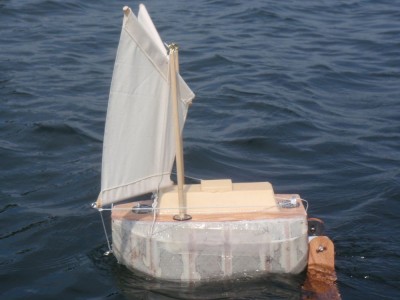
To bee continued…
Regards Yrvind.
OUTSIDE LAMINATE DONE
The outside laminate is now done. For that I needed help. It took some time before frends of mine from all over Sweden cold come on the same day. This is an important step becouse now I can take the boat out of the mould and turn her around and make her mobile for the first time. Click once or twice the pictures to enlarge them.
This is the boat before the start.
Here the crew are almost done. Everything went very smouthly. After four houers we finished. The new NM-epxy 625 with its excellent wetting properties and exteremly long open time made work easy.
The peel ply is coming on. Captain Thomas closest to the camera. We sailed an old Albin Vega from Sweden to Florida. We have now also written a book about the venture, to be published 27 of August.
Job done. The crew pose for a group picture. From left to right, Beppe webbmaster, Yrvind, Peter Ohlman son of one of my class mates, Jonas has built and sailed a boat to my design acraoss the Atlantic together with his wife Ingrid, Jerker from TBB Finance group, he works in the same building and is always willing to give me a helping hand, Monica Ohlman, wife of my Class Mate. Mattias small boat builder from Västerås, the above mentioned Captain Thomas, finally Lars Ohlman, my class mate from childhood. I thank them all for an excellent job and for having survived my bossing.
Laminating done.
Today I have done a bit of cleaning up and peeling the peel ply before the NM-epoxy sets to hard.
Last week we tried to sail the big model. There was no wind. Tomorrow we hope for some.
To bee continued…
Regards Yrvind.
YRVIND TEN LATERAL AREA AND WEATHER PATTERNS
I have not expressed myself clearly. This has lead to misunderstandings by Manie B, Angelique and probably others. It may therefore be of general interest to elucidate some points.
My models are giving me ansvers to two questions. Can a boat that heavy and so short be driven by a small sail area. The ansver found is yes. The next question can a small boat that heavy and fat and beamy be directional stable downwind, – uppwind it is easy. The ansver again found is yes.
I am the designer, the builder and will be the Captain of Yrvind Ten communication between these differnt doers do not have to be with paper. There are many things to do. Therefore my models do not show all the details. It definitly would be better to do proper calculations and have proper drawings. It would be safer way, but it would be more boring and take more time. Therefore the model has no foreward lateral area. The real boat will have that, probably a pivoting centerboard. I have good experience from my own boats and from boats I have designed for others. Several ones have crossed the Atlantic so equipped.
Two times I have spent six months in the roaring forties in small boats. That together with extensive reading and talking to other sailors have given me a good idea of the weather there and there is a lot of missunderstanding.
It is a completly different weather pattern if you are a stationary observer or if you are moving with the weather systems like the clipper ships or the Volvo racers or the Vende singelhanders. If you are moving with the wind at from my point of view very high speed you will get a lot of westerly winds. If on the other hand like Yrvind Ten you move at average two knots you are almost stationary and you will get a lot of easterly winds, not only light winds but also gales. I once lost 150 miles in an easterly gale laying to sea anchor. I do not belive in them anymore. They are for boats that have a fear of capsizing. If you do not mind capsizing keep sailing against strong winds.
There are on the average two or three low pressures coming up from the Antartic each weak with very cold winds. The stationary observer will experince north west winds that will go anticlockwise to south west and the turn to light easterly. But other winds will also happen. The roaring forties is not a strong trade wind, not for a slow mowing boat. A slow mowing boat will experience a lot of windward work and need an efficient lateral area for and aft.
To be continued…
Regards Yrvind.
SHAPING YRVIND TEN AND 1/8 SCALE TEST
There has been some progres. The hull is now shaped. First I used a Festool power planer to get the rugh shape, then I used longbords muscel powered first grain 24 then grain 60 finally the finishing touch with a Festool rotex orbital sander. The wedges made a good fit. On a few places where seweral wedges met i drilled a 20 mm hole and pluged it with a Divinycell plug. The load waterline at 1500 kilos and the centerline are marked.
I have also tested the big1:8 scale model, she confirmed the results from the 1:20 scale modell, that is, I am on the right track. I will improve the down wind performancet by making two more positions for the masts. The added new positions will be, side by side, forward of the hatch, one on each side of the deckhouse. Keep it simple they say. Sometimes an improvement can be worth its complication. Plankton breed by dividing, we breed by sex. It sure is a complication but might be worth it.
Yrvind Ten before shaping.
Click on the pictures once or twice to enlarge.
After shaping.
A Divinycell plug inserted in the drilled hole.
The plug is cut and sanded down. Plug and wedges makes a good fit with the Divinycell quadrangels.
Using the Festool plane. The dust extractor keeps the workshop clean.
The tools used.
The 1/8 modell bow view.
The 1/8 modell fram behind.
The more I work with Yrvind Ten the happier I get. Of course the project is ridiculus but so is plying golf and climbing high mountains. What counts is to do something difficult. That is whats makes a project wortwhile. We human beings are the only animals being bored except wild animals in captivity. Wild animals are happy without entertainment, spices and modern conviniences. You get happy by working to your limits, not by going fast, slow down and happiness will catch up with you.
The next stepp is to laminate the boat. For that I need a few freinds. Male or female young or old do not matter. Important is If you have a positive interest in small boats and are handy and careful and like to lend a helping hand. If so call me at 0490 21530 between 20 and 22 houers any day. The lamination is planned to take place preferably a saturday, the 12th or 19th or torsdag 17 kristi himmelsfördsdag in Västervik. There is no pay and you will get your fingers dirty.
The publishing date for my book is getting close I have to work with the by my editor Malin revised manuscript that will also take some time.
To be continued…
Regards Yrvind.
COMING NEW BOOK IN SWEDISH
The book is about a voyage in an old Albin Vega with a 19 year old student from Sweden to Florida 2007. The translation of title is: The young, the old and the sea. It will be published in August 2012 at Norstedts, Swedens oldest publisher.
Click on the picture once or twice to enlarge.
Regards Yrvind
